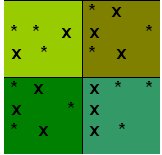COLLECTIVE SPORTS
UNIT: RUGBY
LESSON: 1
We are going to work:
IMPROVEMENT OF EXISTING SKILLS AND INTRODUCTION TO PASSING SKILLS
APPARATUS: Rugby balls, cones/markers, stopwatch
ORGANISATION
CONTENT
TEACHING POINTS
Number of players: 6 to 8.
The playing area may be marked with cones or markers.
WARM UP: ball familiarisation
• Corner Ball:
There are 2 dodgers who dodge other players, the taggers. The taggers try to tag them (dodgers) with the ball. Taggers must not run with ball, but must pass it between them to reach dodgers and tag them (holding the ball with both hands and touching them with the ball). Taggers can only take 1 step when reaching to tag someone. So taggers must co-operate well as a team, passing the ball quickly to one another to make a tag.
The game is played for 60 seconds and dodgers have to try not to be tagged, and then the dodgers should be changed over. If the dodgers are tagged, nothing happens, the game continues till the end of the 60 seconds.
Pushing or bumping with a ball when tagging is not allowed.
Changes to the game:
- Match younger players with those of similar age and ability.
- Make 6 tags before 2 others take over as dodgers.
- For more confident children introduce lives – taggers have 3 lives and lose 1 for each tag. New dodgers take over after all lives lost.
- For less skilful children give 5 (or more) lives and see how many they can keep each time (so that they never lose all their lives).
Easier: Make area smaller. Have only one dodger. Take two steps to tag.

In grids 10m x 10 m or smaller
MAIN PART: skill; passing
• 3 v 3 game.
There are 2 teams of 3 players each. When a team has the ball, the players have to pass the ball to each other in order to get 5 consecutive passes, this counts as 1 point. The ball may be passed in any direction and players can move in any direction while holding the ball. Opposing team attempt to gain possession by intercepting pass. If they can manage it they start to pass the ball to each other to try to pass the ball 5 consecutive times.
If the ball hits the ground or goes out of the grid, the other side gains possession.
• Variation 3 v 3 game.
The game is developed so that if the person in possession of the ball is touched by the opponent – two hands on the hips – he/she must stop and pass the ball within 1 second. If pass is not made within 1 second, opposition gain possession.
Work in pairs.
Two separate lines are assigned for this activity.• Passing activity: Running forwards, passing sideways – no restriction on forward passes.

• Passing activity: Develop passing backwards – no forward or straight passes are allowed.
Children are in groups of three and have to practice backward passes. The child who carries the ball has to try to speed up before passing the ball and then, this child who has passed the ball should slow down – thus the ball carrier should be ahead of the person he/she passes to in order to pass the ball backwards.

GAME:
• Putting passes under pressure
There are four children. At first, A has the ball and passes it to B, then A runs behind B, who passes the ball to C, then A runs after C, who passes the ball to D. Now A runs behind D and attempts to touch D, with two hands on the hips, before he/she scores past the line. It means, after passing the ball to B, A starts to run behind B, C and D, and tries to touch D in order to avoid D scoring. So, when passing ball, A should be ahead of B, B should be ahead of C, and C should be ahead of D because no forward passes are allowed.